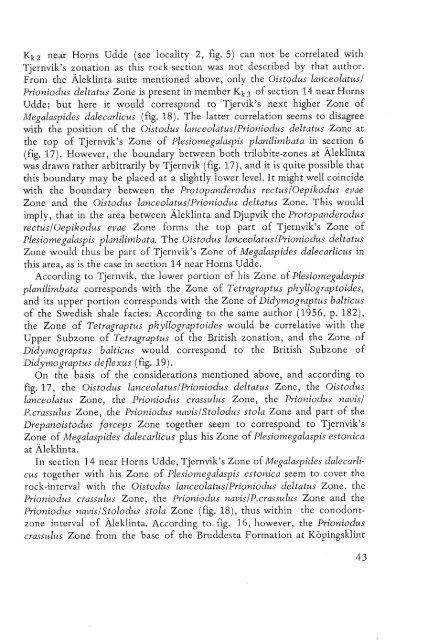UTRECHT MICROPALEONTOLOGICAL BUllETINS
UTRECHT MICROPALEONTOLOGICAL BUllETINS
UTRECHT MICROPALEONTOLOGICAL BUllETINS
Create successful ePaper yourself
Turn your PDF publications into a flip-book with our unique Google optimized e-Paper software.
Kk2 near Horns Udde (see locality 2, fig. 5) can not be correlated with<br />
Tjernvik's zonation as this rock-section was not described by that author.<br />
From the Aleklinta suite mentioned above, only the Oistodus lanceolatus/<br />
Prioniodus deltatus Zone is present in member KkJ of section 14 near Horns<br />
Udde; but here it would correspond to Tjervik's next higher Zone of<br />
Megalaspides dalecarlicus (fig. 18). The latter correlation seems to disagree<br />
with the position of the Oistodus lanceolatus/Prioniodus deltatus Zone at<br />
the top of Tjernvik's Zone of Plesiomegalaspis planilimbata in section 6<br />
(fig. 17). However, the boundary between both trilobite-zones at Aleklinta<br />
was drawn rather arbitrarily by Tjernvik (fig. 17), and it is quite possible that<br />
this boundary may be placed at a slightly lower level. It might well coincide<br />
with the boundary between the Protopanderodus rectus/Oepikodus evae<br />
Zone and the Oistodus lanceolatus/Prioniodus deltatus Zone. This would<br />
imply, that in the area between Aleklinta and Djupvik the Protopanderodus<br />
rectus/Oepikodus evae Zone forms the top part of Tjernvik's Zone of<br />
Plesiomegalaspis planilimbata. The Oistodus lanceolatus/Prioniodus deltatus<br />
Zone would thus be part of Tjernvik's Zone of Megalaspides dalecarlicus in<br />
this area, as is the case in section 14 near Horns Udde.<br />
According to Tjernvik, the lower portion of his Zone of Plesiomegalaspis<br />
planilimbata corresponds with the Zone of Tetragraptus phyllograptoides,<br />
and its upper portion corresponds with the Zone of Didymograptus balticus<br />
of the Swedish shale facies. According to the same author (1956, p. 182),<br />
the Zone of Tetragraptus phyllograptoides would be correlative with the<br />
Upper Subzone of Tetragraptus of the British zonation, and the Zone of<br />
Didymograptus balticus would correspond to the British Subzone of<br />
Didymograptus deflexus (fig. 19).<br />
On the basis of the considerations mentioned above, and according to<br />
fig. 17, the Oistodus lanceolatus/Prioniodus deltatus Zone, the Oistodus<br />
lanceolatus Zone, the Prioniodus crassulus Zone, the Prioniodus navis/<br />
P.crassulus Zone, the Prioniodus navis/Stolodus stoIa Zone and part of the<br />
Drepanoistodus forceps Zone together seem to correspond to Tjernvik's<br />
Zone of Megalaspides dalecarlicus plus his Zone of Plesiomegalaspis estonica<br />
at Aleklinta.<br />
In section 14 near Horns Udde, Tjernvik's Zone of Megalaspides dale carlicus<br />
together with his Zone of Plesiomegalaspis estonica seem to cover the<br />
rock-interval with the Oistodus lanceolatus/Prioniodus deltatus Zone, the<br />
Prioniodus crassulus Zone, the Prioniodus navis/P.crassulus Zone and the<br />
Prioniodus navis/Stolodus stoIa Zone (fig. 18), thus within the conodontzone<br />
interval of Aleklinta. According to fig. 16, however, the Prioniodus<br />
crassulus Zone from the base of the Bruddesta Formation at Kopingsklint
















